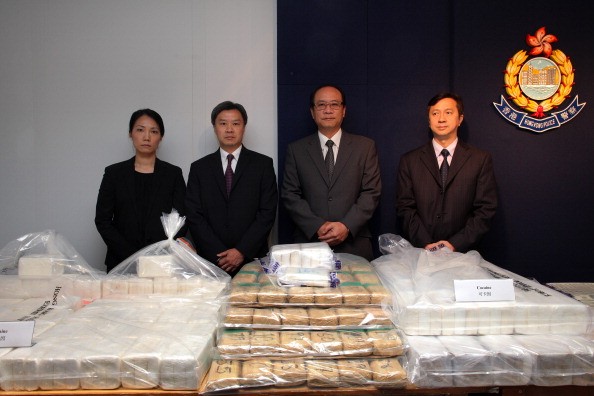Chinese Police Arrest 1,500 Foreigners for Drug Trafficking
| Desiree Sison | | Feb 19, 2016 07:39 AM EST |
(Photo : Getty Images) The drug menace has become a major headache for China, prompting the police to intensify their crackdowns on drug traffickers and users.
Chinese police stepped up their crackdown on drug trafficking syndicates last year, busting more than 5,900 drug pushing gangs - this represents an 18.1 percent increase compared to the figure recorded in the same period in 2014.
The National Narcotics Commission said on Thursday that of those arrested for drug trafficking, 1,500 were foreigners from 39 countries including Myanmar, Nigeria, Vietnam, and Pakistan.
Like Us on Facebook
The commission noted that rampant drug trafficking is also taking place online with 15,000 drug sales cases aborted by the police last year.
Drug-related crimes
The Commission expressed concern over the high incidence of drug-related crimes in the mainland, prompting the authorities to intensify their crackdown.
According to the gathered data, the number of drug-related crimes rose to 174,000 last year, accounting for 14 percent of all criminal cases which include murder, kidnappings, robberies, and rape.
The commission said the number of drug users in the country has also risen significantly.
2.3M drug users
There were more than 2.3 million drug users recorded in China last year. Of this number, more than a million were arrested, the report said.
The recorded number of arrests represents a 20 percent increase compared to the arrests made in 2014.
Almost half of the 1,062,000 people arrested last year were reportedly new offenders, a 14.6 percent increase compared to the number of first time offenders recorded in 2014.
Amphetamine
The report said more than half of those arrested last year (72.6 percent) abused amphetamine (known by its street name 'ice') as the drug of their choice and 80.5 percent used assorted drugs. Opioids and heroin were also highly abused by the offenders.
Of the 2.3 million drug users, more than half or 60.6 percent were between the ages of 18-35, while 1.8 percent were below 18. About 37.6 percent were aged 36 and above, the commission said.
Young students were the lowest number of drug users arrested at 0.5 percent ,while the number of farmers was pegged at 18 percent. Around 70 percent were unemployed.
Records shows that the farmers and laborers were the most involved in drug trafficking at 80 percent, while the rest of the drug pushers were the youth.
Other offenders who were caught pushing drugs include civil servants, laborers and students.
TagsNational Narcotics Commission, Chinese police, foreigners, drug menace
©2015 Chinatopix All rights reserved. Do not reproduce without permission
EDITOR'S PICKS
-

Did the Trump administration just announce plans for a trade war with ‘hostile’ China and Russia?
-

US Senate passes Taiwan travel bill slammed by China
-

As Yan Sihong’s family grieves, here are other Chinese students who went missing abroad. Some have never been found
-

Beijing blasts Western critics who ‘smear China’ with the term sharp power
-

China Envoy Seeks to Defuse Tensions With U.S. as a Trade War Brews
-

Singapore's Deputy PM Provides Bitcoin Vote of Confidence Amid China's Blanket Bans
-

China warns investors over risks in overseas virtual currency trading
-

Chinese government most trustworthy: survey
-

Kashima Antlers On Course For Back-To-Back Titles
MOST POPULAR
LATEST NEWS
Zhou Yongkang: China's Former Security Chief Sentenced to Life in Prison

China's former Chief of the Ministry of Public Security, Zhou Yongkang, has been given a life sentence after he was found guilty of abusing his office, bribery and deliberately ... Full Article
TRENDING STORY

China Pork Prices Expected to Stabilize As The Supplies Recover

Elephone P9000 Smartphone is now on Sale on Amazon India

There's a Big Chance Cliffhangers Won't Still Be Resolved When Grey's Anatomy Season 13 Returns

Supreme Court Ruled on Samsung vs Apple Dispute for Patent Infringement

Microsoft Surface Pro 5 Rumors and Release Date: What is the Latest?













